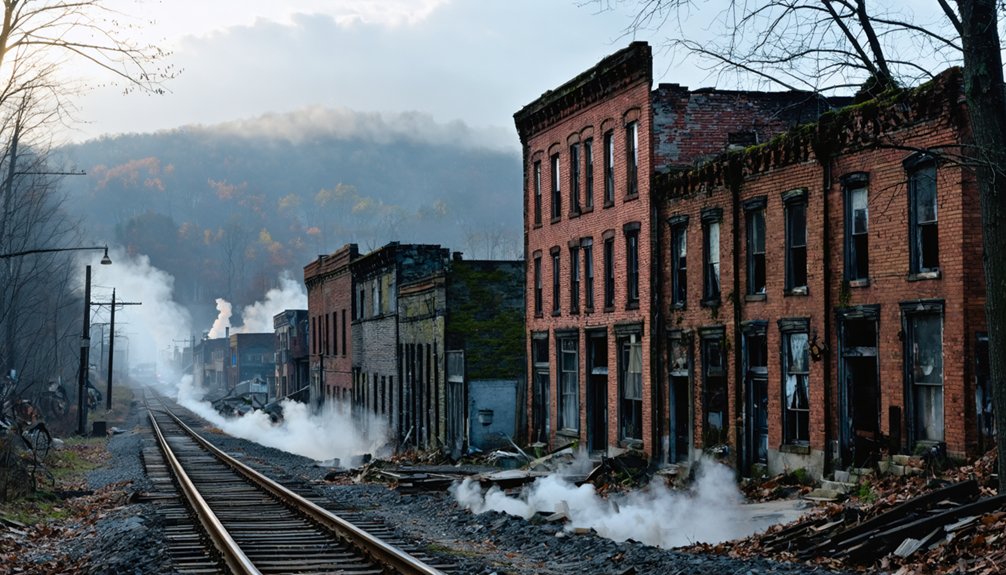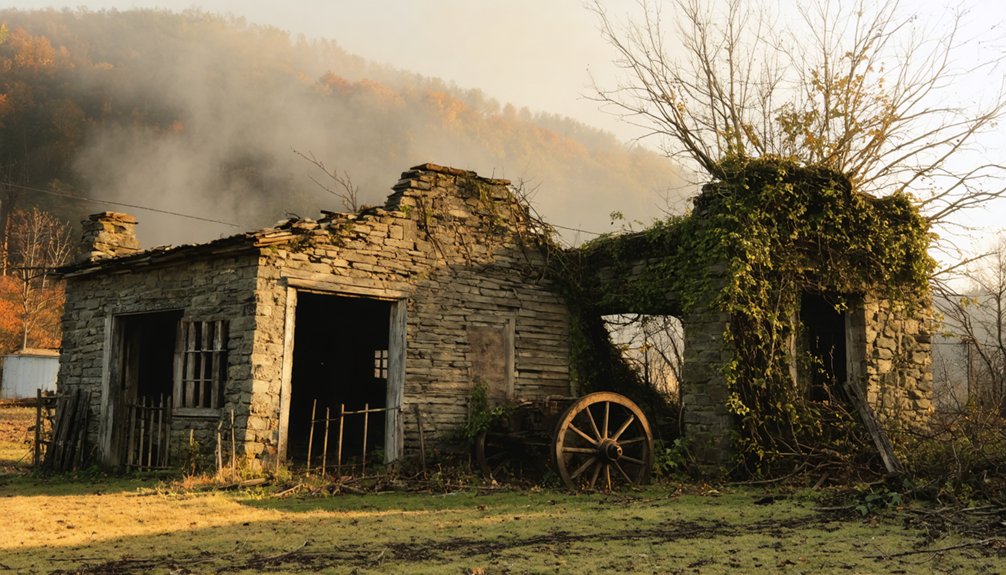America’s most compelling Civil War-era ghost towns include Bodie, California, where gold rush buildings remain in “arrested decay” with original belongings intact; Cahaba, Alabama, the former state capital with visible ruins of Union prisoner-of-war camp Castle Morgan; and Fort Jefferson, Florida, an isolated island fortress that imprisoned Lincoln assassination conspirators. You’ll walk abandoned streets where soldiers, miners, and prisoners once trod, their stories preserved in weathered bricks and forgotten foundations.
Key Takeaways
- Cahaba, Alabama, was once Alabama’s state capital before becoming a Union prison site, now preserved as an archaeological park.
- Fort Jefferson in Florida served as a remote prison for Union deserters and Lincoln assassination conspirators during the Civil War.
- Harpers Ferry, West Virginia, witnessed John Brown’s raid and changed hands eight times during the Civil War.
- Andersonville, Georgia, housed the infamous Confederate prisoner-of-war camp where 13,000 Union soldiers died.
- Ellicott City, Maryland, features Civil War-era buildings and served as a strategic railroad junction during the conflict.
Bodie, California: The Gold Rush Town Frozen in Time
In the rugged eastern slopes of the Sierra Nevada Mountains, the ghost town of Bodie stands as a monument to America’s gold rush fever, its weathered structures frozen in the amber of historical preservation.
Discovered in 1859 when William S. Bodey struck gold, this once-thriving settlement exploded into a boomtown of nearly 8,000 souls by 1880.
You’ll witness authentic Bodie history through the 110-170 remaining buildings maintained in “arrested decay.”
Peer through windows into homes where personal belongings remain undisturbed since the last residents departed in 1942.
The town earned its notorious reputation as the “Badman from Bodie” became a phrase describing its wild inhabitants.
The gold mining operations that yielded $38 million in precious metals have long ceased, but California’s official gold rush ghost town invites you to walk streets once teeming with miners, merchants, and madams—a genuine glimpse into frontier life unmatched elsewhere.
Located off US 395 between Bridgeport and Lee Vining, this historic site offers visitors a stunning view of the Sierra Nevada mountain range.
Cahaba, Alabama: From State Capital to Civil War Ruins
At the confluence of the Alabama and Cahaba Rivers stands the haunting remains of Cahaba, Alabama’s first state capital and one of the South’s most profound Civil War ghost towns.
You’ll find a reflection of dramatic transformation in Cahaba’s history—from thriving political center in the 1820s to wealthy antebellum cotton hub by 1860, when two-thirds of its 2,000 residents were enslaved.
During the war, the Confederacy converted a warehouse into Castle Morgan, imprisoning 3,000 Union soldiers in space meant for 500. The town experienced a devastating flood in February 1865 that caused extensive damage to its structures.
The suffering of thousands echoed through Castle Morgan’s walls—a testament to war’s cruel arithmetic.
After losing its county seat status and railroad connections to Selma in 1866, Cahaba declined rapidly. Today, visitors can witness the ghostly orb phenomenon that locals have reported seeing near the ruins of Colonel Pugues’ former residence.
Today, as Old Cahawba Archaeological Park, you can walk abandoned streets where Cahaba archaeology reveals over 100 building foundations—silent witnesses to a once-prominent town that hosted freedmen’s political organizing during Reconstruction.
Fort Jefferson, Florida: The Remote Island Prison Fortress
Seventy miles west of Key West, surrounded by the azure waters of the Gulf of Mexico, stands Fort Jefferson—an imposing hexagonal fortress that represents one of America’s most isolated Civil War ghost towns.
Built with over 16 million bricks yet never completed, this massive structure housed Union deserters and Lincoln assassination conspirators, including Dr. Samuel Mudd, who once attempted escape before being relegated to the dungeon bearing Dante’s ominous warning.
- Prisoners outnumbered guards within the fort’s 16-foot thick walls, creating a perilous balance of power.
- Yellow fever epidemics ravaged the isolated garrison, filling the now-submerged cemetery with forgotten souls.
- Conspirators lived in cramped quarters as waves crashed against the remote island’s shores.
- Mudd’s medical skills during the 1867 yellow fever outbreak earned him a pardon.
- The abandoned prison fortress now stands as a monument to Civil War prison history.
Recent archaeological surveys revealed a submerged cemetery containing the grave of John Greer, a laborer who died in 1861 during the Civil War.
The fort is the largest brick masonry structure in the Western Hemisphere, a testament to America’s 19th-century military engineering prowess.
Frequently Asked Questions
Are Ghost Towns Legally Accessible or Require Special Permits?
Ghost town regulations vary. You’ll find legal access to public lands without permits, but you must obtain permission for privately-owned sites. Federal and state entities enforce different access requirements.
What Paranormal Activities Have Been Reported in These Locations?
In these shadowy portals to the past, you’ll encounter haunted legends including spectral sightings of miners and soldiers, mysterious orbs, unexplained sounds, moving objects, temperature fluctuations, and disembodied voices—vestiges of America’s untamed frontier spirits.
Can Visitors Take Artifacts or Souvenirs From Ghost Towns?
No, you mustn’t remove artifacts from ghost towns. It’s illegal under federal laws and violates ethical considerations of artifact preservation. You’ll face fines and possibly criminal charges for disrupting historical integrity.
How Dangerous Are Abandoned Structures for Tourists?
Abandoned structures pose significant dangers. You’ll encounter compromised structural integrity, hazardous materials, and unstable floors. Always implement safety precautions like proper footwear, avoiding weight-bearing tests, and maintaining vigilance for sudden collapses.
Which Ghost Towns Offer Guided Night Tours?
Like moths to a flame, you’ll find Gettysburg offers the most robust night tour experiences, with guided walks exploring the town’s Civil War ghost town history through haunted sites and battlefield apparitions.
References
- https://www.loveexploring.com/gallerylist/131658/abandoned-in-the-usa-92-places-left-to-rot
- https://en.wikipedia.org/wiki/Wikipedia:WikiProject_Ghost_towns
- https://www.mentalfloss.com/geography/american-ghost-towns-can-still-walk-through
- https://www.ghosttowns.com
- https://www.visittheusa.com/experience/5-us-ghost-towns-you-must-see
- https://www.outsideonline.com/adventure-travel/destinations/north-america/most-adventurous-ghost-towns-u-s/
- https://www.christywanders.com/2024/08/top-ghost-towns-for-history-buffs.html
- https://en.wikipedia.org/wiki/Ghost_town
- https://www.geotab.com/ghost-towns/
- https://noospheregeologic.com/blog/tag/ghost-towns/



